Realistic Console Racer Soup 2017: Principles of Innovation in Racing Games
Last fall, renowned automotive magazine Car & Driver published the story of its 2017 “Lightning Lap.” The magazine gathers the best new performance cars each year and take them to Virginia International Raceway (VIR) for the annual Lightning Lap. This year, thunderstorms threatened and then ruined the magazine’s scheduled window for testing at the raceway. The editors sat instead in the paddocks playing cards and doing other nonsense as the rain fell and the brilliant and attractive cars sat idle. One doesn’t fantasize about running a new Chevrolet Camaro ZL1 or Mercedes-Benz AMG GT R or Porsche 911 Turbo S around perhaps the most demanding racetrack in the US during a thunderstorm, and even the professional automotive journalists didn’t “hoon” around the track sideways in rally-bred cars like the Subaru WRX Performance.

Undeniably, some of the most iconic motorsport events occur or can occur at night, in the rain, or in other inclement weather. Yet Car & Driver‘s Lightning Lap shows what is otherwise patently obvious to anyone who has ever driven a car in those conditions—no one would prefer driving VIR at night, or at night in the rain, to lapping during the day in clear conditions. The 24 Hours of Le Mans and other endurance races showcase stamina, attrition, and team-based motorsport. These races include night stints as part of the natural challenge, just as rallying uses differing surface types or NASCAR uses night, but find a professional sports car driver who prefers or enjoys those conditions to dry, noon sun. Ken Block’s radical Gymkhana series is a wowing spectacle of supreme car control, and yet that rarefied performance represents a minor subset of motorsports (e.g., Gymkhana 9).
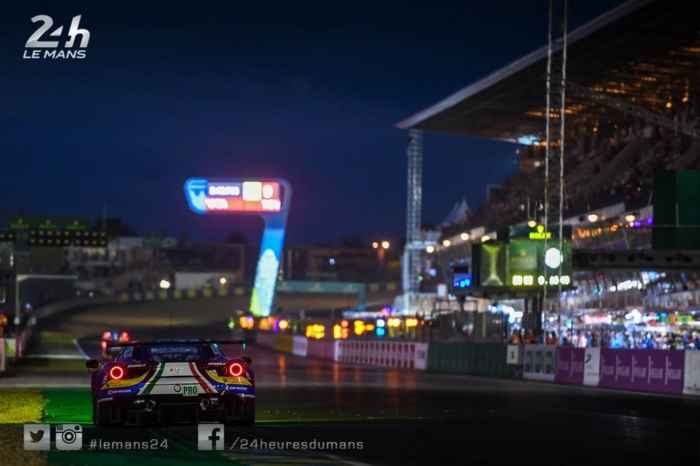
It’s a wonder, then, that the latest releases in console racing games in Fall 2017 include a vast array of required experiences with varying weather. Project CARS 2 boasts its “Live Track 3.0” system with a truly impressive arrangement of conditions and variance in conditions across a race, while Forza Motorsport 7 touts improvements and upgrades to the conditions found in Forza Motorsport 6 and Forza Horizon 3. In either game, players should expect to race in the rain in the half-light of a track and to race at dusk in a blinding haze. These and similar racing experiences do not fit any idiomatic definition of fun, and suggest one of the ways game developers have misunderstood progress.
Innovation in Console Racing Games
This article is not a critical review of Forza Motorsport 7, Project CARS 2, or Gran Turismo Sport; instead, it considers the state of console car and racing games more holistically and conceptually. They each show promise and each evidence lack of innovation. Each game’s relative failures do not suggest these games are not good. Based on Metacritic aggregates as of October 27, critical reception to Forza Motorsport 7 is 86/100, Gran Turismo Sport is 76/100, and Project CARS 2 is 86/100 (on Xbox One) and 83/100 (on PS4). Metacritic user scores paint a different image, representing less nuance than critics and more general discontent at a game’s promise and expectation fulfillment (Forza 7 5.8, Gran Turismo Sport 6.2, Project CARS 2 5.5 on Xbox One and 5.8 on PS4). Data from previous games in these series show that critical and user aggregates are generally lower for the new games. For instance, Forza 7‘s scores (86; 5.8) compare unfavorably to 2015’s Forza 6‘s (87; 7.7) and to 2016’s Forza Horizon 3‘s (91; 8.0), while Gran Turismo Sport‘s (76; 6.2) show an even more dramatic gap to 2013’s Gran Turismo 6 (81/8.1).
Innovation Through…Meteorology?
The experiences described above are one possible way to account for that decline. Put simply, again, racing at night in the rain may represent some actual racing scenarios, but it isn’t fun. More importantly, the addition of night racing and of varieties of inclement weather, perhaps especially in natural variance and evolution while racing, represents graphical enhancements and dynamic changes rather than innovations. Forza 6 introduced rain to the series, for instance, and an incredible, unloved moat across turn 9 at Sebring International Raceway that forced players to rethink the track and manage wild hydroplaning. Forza 7 smoothed some of these radical and unrealistic conditions while doubling down on rain variance, sky types, and track conditions. Single player campaigns in both Forza 7 and Project CARS 2 both introduced me to new tracks and configurations during races with forced night and forced rain—or even more confounding conditions—that greatly diminished visibility and thus learning the track.
None of this is to say this meteorological and track variance is not impressive or gorgeous—it frequently is stunning.
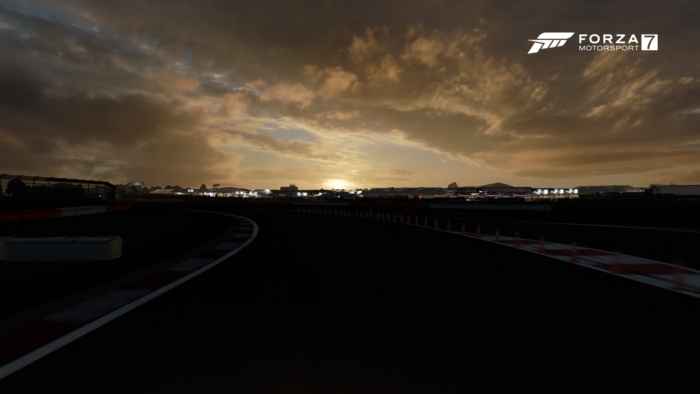
Graphically, the games demand attention. Car games always have for consoles, just as nature scenery does for the showroom 4K TVs now and the tube TVs from 20 years ago at the local Best Buy. In that way, the first time paint reflected the sky or the rumble strips in a racing game is little different than when Kazunori Yamauchi remarked that the next stage of visual fidelity for cars in games was imperfection, accurately modeling the accumulation of dirt and damage. Gran Turismo Sport is the current iteration of his pursuit of fidelity, and the new “Scapes” showcase a newfound realism. And yet innovation impacts the way we play games more than how they look.
Innovation and Absurdist AI
Gamers have long identified one of the foremost innovations needed in racing games—AI and racing PVE experiences. Gorgeous skies and rain-slicked pavement, or what a good friend called “eye candy,” serve to psychologically exacerbate frustration at the incredible stagnation in AI systems. The most prominent, specific AI criticisms over the years have included these:
-Rubber-band AI or AI that simulates competitiveness by artificially boosting or slowing drivers.
-Train AI or AI that moves around a track as if on train rails, even when impacted or when objects are on those rails and easily avoidable.
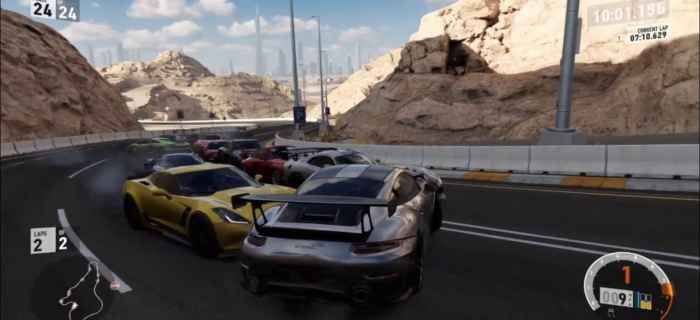
For an excellent example of both, see Darth Raider’s remix of TheGamersTrailer’s video from Forza 7.
Turn 10 warrants special attention for its attempts to innovate racing AI with its “Drivatar” system from previous games and in Forza 7. That system promised an adaptive AI based on real-world players and their profiles. In practice, the Drivatar system is imperfect. When you see a Level 1 Drivatar clipping apexes and hot-lapping during a race with Level 20 Drivatars behind, for example, you are allowed skepticism of authenticity. Without doubt, contemporary AI in Forza 7 and Project CARS 2 bests old AI systems, particularly as AI cars move to pass one another, run off or spin, and generally behave more like real racers. These AI systems both also falter under scrutiny. Even with homologated cars in Forza 7, Drivatars can turn in laps considerably faster than the field, for instance, and in Project CARS 2, the dreaded rubber-band effect in qualifying happens when you exit before the timer expires only to find that your comfortable pole was eclipsed by full seconds. In either game, players can also stop in certain corners and watch as the AI stacks up behind, seemingly unable to “see” the car in front or understand how to move around the obstruction (with open room on the track to do so).
AI in Forza 7 and Gran Turismo Sport warrant particular notes relative to ludic components of racing. Forza 7 stacks Drivatars on a race grid in predetermined ways, often with the fastest Drivatars in the top two positions and always with the player in the middle or end (unless adjusted with an in-game “mod” perk). Starting a championship from 12th position requires the player muscle through to first, at defaults, in two or three laps. Consider the AI difficulty sliders. If you want to race Drivatars lapping near your times, your goal becomes racing through the field to catch the Drivatar(s) at the front with open track (and invariably a substantial lead), while decreasing the difficulty still requires you muscle through a slower field to catch and pass the Drivatar that has broken away and opened up a lead. In the third of six races in a championship, you again start in 12th and the same driver from 1st remains in 1st. Credits, XP, and championship points remain relatively stagnant, and the player is still massively incentivized to win every race. Win too frequently, though, and Forza 7 vocally chides you, “you’ll never get better” if you don’t challenge yourself with harder AI. Racing is not about forever chasing down the fastest racer, from 12th to 1st, and starting grids aren’t fixed in this way.
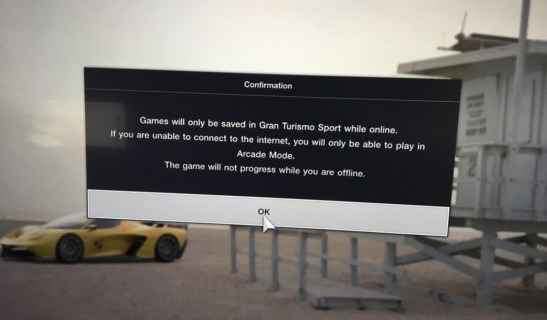
While Forza 7 fails to substantially improve AI and artificially frames ludic components to suggest “challenge” in racing, Gran Turismo Sport almost entirely dismisses AI. As effectively a DRM/always-online game, with its own gamut of problems, Gran Turismo Sport almost wholly becomes a PVP racing game. While AI innovation remains elusive, PVP racing is as idiosyncratic as players. Reviews of Gran Turismo Sport show critic and player dissatisfaction with this form of opponent in a couple of ways. First, Kazunori Yamauchi built a franchise around AI. His personal interests and involvement in racing clearly prompted the shift to Sport‘s esport PVP focus, but longtime Gran Turismo players most asked Yamauchi for improvements to the core game, not a radical dismantling of it. Some players, then, find the no AI experience to be a detraction, some reasonably noting that they do not want to or admit to not being proficient enough to compete against other humans (or casual gamers like bugtrainer who find all this and the DRM/PS Plus requirements to be “a waste of money”). Second, as in most console racing games, but not as prevalent in PC games like iRacing, players contend with a wide range of player interest, sportsmanship, and ability. Gran Turismo Sport attempts to group players into cohorts according to their interest, sportsmanship, and ability, but at least early in release, players complain about ineffective systems (e.g., penalizing both players for a shunt maneuver by one) and about matched players with diverse goals (e.g., clean, professional racing vs. chaos or drifting).
Finally, one of the ways Forza 7 has addressed AI is through homologation. Homologation happens all the time in racing, and it’s the process of regulating cars to be as competitive as possible. These regulations commonly address weight, engine type and size, body shape and wings, tire compounds, and more. Like grid positioning, though, homologation presents an artificial challenge. Enforcing homologation and relegating specific cars to homologated leagues further undermines one of the central features of car games like Gran Turismo and Forza—modification and tuning. Disable swapping wheels and engines for homologation, and longtime players will (and did) balk.
Innovation Through Player Choice
Beyond the false innovation of meteorology and the lack of AI innovation, Forza 7 and Gran Turismo Sport abhor rather than experiment with or embrace player choice. Project CARS 2, notably, follows Project CARS in offering players its full roster of tracks, cars, and weather conditions with which to play. Its career mode offers more flexibility and choice than did Project CARS‘ original, and players may do just about anything in the game they want. Winning is incentivized in the career, so as to move on to the next tier of championships, and unlike in Forza 7, there is no particular deterrent to finishing in 12th.
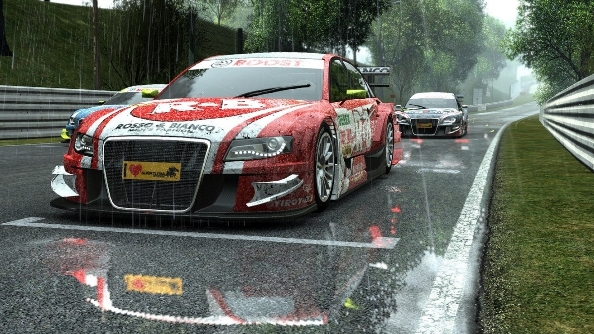
To its credit, Forza 7 does a much improved job of incentivizing playing, offering championship points, XP, and credits for all positions and every race. Unfortunately, the game continues to massively incentivize winning and doing so on the most difficult settings. This tension between playing and winning seems at odds with Turn 10’s stated interest in appealing to a broad gamer base and imbuing in them an appreciation of cars. Forza 7 further complicates this intention by newly locking most of its cars behind not just an in-game credit wall, but also behind championship progress and limited-time events.
Most baffling is why Forza 7 didn’t lift and develop player-choice ludic systems from Forza Horizon 3. I argued previously for player choice in video games and in console racing games, and I reiterate that argument here. The “Blueprint” races and championships in Forza Horizon 3 were truly innovative—rather than set out determined championship conditions as in all previous racing games, Horizon 3 allowed players to determine the tracks, routes, cars, length, weather, and more for its career/campaign. That is, Horizon 3 offered players Blueprints; the game did not require them. Horizon 3 also used a form of homologation, arranging performance of AI/Drivatar opponent cars to the one the player chose to race. The car cohorts were not limited by homologation restrictions as they are in Forza 7, instead the player determined the way the cohort would be homologated based on his/her own preferences.
One discordant element of Gran Turismo games, for years, has been race grids determined by performance indexes rather than by any fundamental automotive grouping. Thus constructed, gamers ended up with race grids comprised of rally cars, touring cars, open-wheel cars, and the “vision Gran Turismo” concept cars. Or an incongruent collection of cars, most which have never and will never be in the same space outside of an eclectic manufacturer museum. As IGN’s Luke Reilly writes, these concept cars “look completely incongruous pitted against normal, modern LMP1 cars.” While Gran Turismo Sport continues the absurd tradition, Horizon 3 offered a homologation tool for starting grids of rationally grouped cars based on the player’s chosen car. If the player engine-swapped a V8 into her Honda Civic and added racing slicks, for instance, the game would stack hot hatches on the grid that were homologated to match the performance of her Civic. In previous Gran Turismo and Forza games, her Civic would end up on a grid of true race cars and Ferraris and Lamborghinis. Why Forza 7 constrained car cohort with performance regulations is baffling, then, disallowing her Civic to compete in or out of career mode.
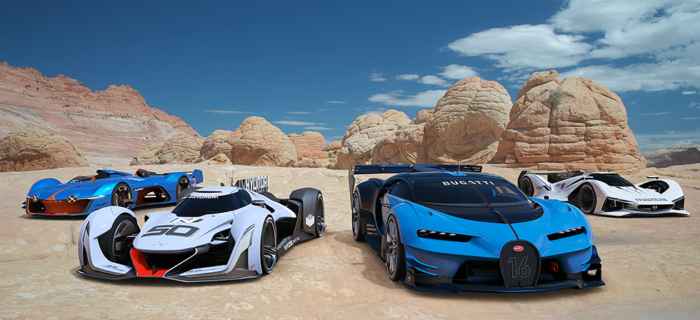
The “blueprint” innovation in Horizon 3 marked a true, fundamental innovation in console racing games. So, too, did the way Project CARS and Project CARS 2 utterly scrapped the tradition of grinding for cars and championship types. I last argued that choice was one of the greatest innovations in console racing games, and I reiterate that claim. These games might incentivize choice more than they do and open the genre up to more players. Points/credits might be scaled and awarded based on starting position, difficulty, assists, car performance, and more, for instance. That monster Civic could race a field of Indy cars if the player wanted or utterly dominate a field of stock hot hatches. Expanding the openness in Project CARS and the creative freedom in Horizon 3‘s “blueprint” would certainly be more substantial and welcome innovations than the ability to unrealistically drown Laguna Seca in a nighttime blizzard.
Moving Toward Substantial Innovation
Project CARS 2 launched to praise for massive improvements over the original, but continued concern with AI and with the narrow focus on sim-type (non-casual) gamers. Forza 7 launched soon after to similar praise, particularly for the revamped career mode, but also to concerns about AI, mismanagement and player complaints about “VIP” benefits, restrictive homologation, and the strange absence of Forzathon, multiplayer leagues, the auction house, or the marketplace. Gran Turismo Sport launched to praise of the visual fidelity in truncated reviews and concerns about the radical reduction in cars, sparse track list, skeletal gaming experience, and singular esports focus. These console racing games have less overlap than they ever have, making dogmatic “fanboy” rants largely irrelevant. And yet it’s worth doubling down on the argument that they would each be improved by focusing on substantial innovation, and on the surprise that they haven’t.
What do you think? Leave a comment.











Thanks for a great article on racing games. I’ve played lots of Gran Turismo recently, and since switching to PC, quite a bit of Race Room Racing Experience and Assetto Corsa. I’d say the handling in all three is very similar. The difference is the collision physics – in Gran Turismo you can drive straight into a pack of cars and probably bounce off them and end up ahead of them. You can also sideswipe somebody when passing them at high speed and it has no effect on your car. In both Race Room and Assetto Corsa, that sort of thing will send you spinning off the track. It makes a huge difference because you actually have to wait for the opportunity to pass, instead of just shoving your way past everybody.
Some of these are simulations of driving instead of a games of driving.
I’m usually a fan of more realistic racers, but I couldn’t ignore the fun to be had in games like Forza Horizon 3. It’s a throwback to games such as Need For Speed, Burnout and Ridge Racer. Love it.
A great article and I’m pleased to see it go live. Well researched (many hours spent at the wheel?) and an absorbing read. Two thumbs up from me:)
What a fun topic😀
My favorite is Gran Turismo 6. It has the most realistic driving physics. The cars behave like they are supposed to like in real life. The biggest thing I notice is you can actually feel your cars weight being shifted in GT when you turn. Other games just turn. There is no weight in other games.
No. It doesn’t and they don’t. All of Gran Turismo’s “physics” are mostly tricks to make you THINK they are realistic. The actual calculations are very limited compared to games like iRacing or GTR2.
I remember when Gran Turismo 4 first came out and introduced visual body roll. Compared to GT3, it was a massive step forward for recreating a more “realistic” performing car game, but it was just an aesthetic difference. PC sims will always trump console games when it comes to actual realistic physics, because there is no processing limitations on PC.
Gonna jump on the Gran Turismo 6 wagon. That’s always sort of been that franchise’s schtick, trying to be realistic racing.
PCARS has given me so many racing thrills every race is adrenaline filled and gaining a position is a real achievement when you’ve been trying for 5 laps to pass the car in front.
Lovely read.
Every year, Codemasters releases a new version of its official Formula 1 game, but this year’s title is one of the best.
Another fantastic article on racing. Enjoyed the one you published some while back and this one as well. Thank you.
If you’re a game developer wanting to maximise enjoyment for the player, then compromises on realism will almost certainly be necessary.
Great article. It’s always a trade-off between realism and playability.
The most realistic racing game for me would probably be iRacing on PC.
I’d put Project Cars at the front of the pack followed by Forza or DriveClub.
Grand piece you have here.
I feel like when the realism is not the main agenda, the game tends to be more enjoyable to experience. There are exceptions, and those are the masterpieces.
Project Cars 2 might not have the support or resources of some other racers, but it’s the best game around for car enthusiasts.
I would say Grid Autosport is the closest thing to real racing. On the hardest difficulty the racing is hard but mostly fair, with the AI behaving as you would expect on track. I’ve stuck mostly on single seater/touring car racing on it, but have been very surprised by how challenging the races can be, sometimes just getting on the podium can be an achievement in some races. (This opinion is based on myself having raced motorcycles/rallycross at national level).
Assetto Corsa is the best racing sim you can buy in 2017.
Racing games are becoming more realistic all the time, and I recommend everyone to get a steering wheel which is the best way to experience them!
I’ve never been a particular fan of racing games, but I found this article very interesting nonetheless!
The thing is, while i agree with Paul in applaud racing games for both making life-like graphics and taking more steps to be as realistic as possible for the player’s enjoyment in recent years, (as most can attest to that when you drive/play the games cars with an actual mock steering wheel and pedals – the experience is almost like a simulator), it is the modern greedy fundamental business practices built into racing games that let them down.
Indeed, it seems like racing games and their developers (and indeed almost the entire video game industry as a whole over the past decade) have moved, wrongly in my opinion, to charging a player real life money (in excess with the original game price) for almost anything that corporate thinks they can sneak under the oftentimes naive and financially capitulating player-base’s nose.
One only has to look at the Forza franchise as a whole over the last 5 years as an example, where more modern additions, like Forza Motorsport 7, have reached the stage where some 150 cars are classified as “exclusive content.” Why is this such a big deal one may ask? Well, these “exclusive content” cars are indeed just that, as, these cars are not available through ‘grinding’ through the game or earning XP (as a player might have expected in years yester) but instead by either: buying ‘tokens’, a in-game currency which while not currently purchasable by real world money, Turn 10 has expressed its desire to turn into a ‘micro-transaction’; or through random loot boxes in the game where a player can spend a HUGE amount of fictional game ‘credits’ (comparatively with the credit earnings they receive at the end of each race) and still not be guaranteed the car (or even car parts) they payed for (think of the FIFA franchise’s card packs). This, in comparison with the last ‘good’ racing game i played, Forza Motorsport 4, where everything was free (bar the original price for the game and free monthly DLC) and the limits on a players choice of cars, weather, race mode and track (of which there were over 10x more of than the game’s sequels) were only limited by the player’s own biases/choices, leaves me questioning the state of modern racing games and the video game industry (and audience) in general. Rant over.
this is what I’m looking!
I’m a member of iRacing on my desktop computer, and I enjoy how realistic it is. Physics are a huge deal to me in all car-related games and one thing I’ve noticed in (almost) all console games is that the controls move the car itself, as opposed to just the wheels. In iRacing and Asseto Corsa, the steering inputs move the wheels, which affect the car independent of its current momentum and aerodynamic force. The steering axle is doing the work. However, having played various racers on a console, it feels way too easy to turn the car and it feels like the controller is shifting the car’s momentum as opposed to its wheels.